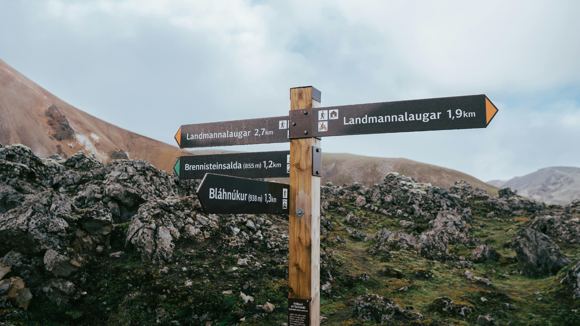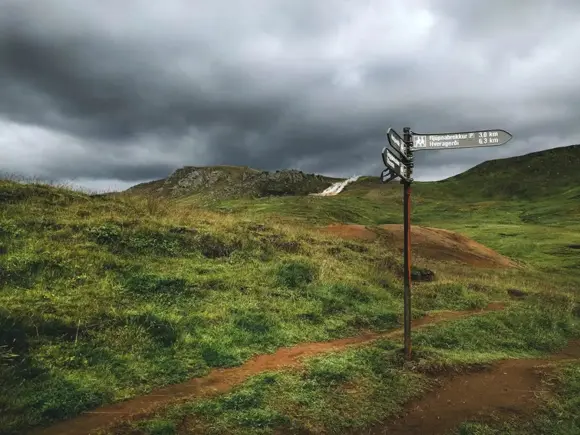Icelandic phrases

Icelandic Phrases For Visitors
The Icelandic language is a notoriously difficult one for foreigners to learn. Like most things in Iceland, the country’s isolation means that the language has remained uninfluenced by outside sources, and therefore, unchanged for decades. Pronunciation can take practice, and the alphabet contains letters that don’t appear in the English alphabet, which is why you may stumble over place names across the country.
English is taught from a young age in Iceland, meaning there will rarely be any huge barrier to understanding when you visit. However, as it is such a huge part of Icelandic culture, learning some basic Icelandic phrases will never go amiss. Let’s first take a look at why the Icelandic language is the way that it is.
Brief History of the Icelandic Language
As mentioned above, modern Icelandic has maintained strong links to its humble beginnings in Old Norse. The first Norse settlers arrived from Norway in the 9th century, bringing their language with them. Due to the geographical location of the island, near impenetrable to other ancient nations, the ancient language is incredibly similar to the language spoken today in Iceland, making it one of the best preserved languages in the world.
It is not just through word of mouth that Icelandic has perpetuated - it has a deep history of folklore, literature, and dedication to linguistic purity. Mediaeval texts like the Icelandic Sagas and other ancient poetry are studied today and can still be understood by native speakers, with some effort!
Icelandic is not just communication, but a matter of national identity for Icelanders, which is why such effort is taken to preserve it.
Pronouncing Icelandic Words
As English speakers, pronouncing other languages does not come easily. It’s useful to take an overview of key differences in pronunciation between English and Icelandic. As a Germanic language, Icelandic shares common elements with Scandinavian languages, such as Norwegian, Dutch, and German. As a result, some knowledge of these languages might help when tackling Icelandic phrases.
First of all, let’s take a look at the letters in Icelandic that do not exist in the English alphabet. These letters are Þ (þ), pronounced “thorn”, and Ð (ð), pronounced in modern English as “eth” or “edh”. Thorn (Þ) is pronounced as a voiceless fricative “th”, like the first sound in the English word “thin”. Eth (Ð) is a voiced fricative, as in the starting sound in English words like “there”. These two letters appear frequently in the Icelandic language so it’s great to understand what they represent.
Other consonants can also be tricky to pronounce for English speakers. In some languages, they often remain similar. However, Icelandic might be different from what you’re expecting. See below for some of the most notable different consonant pronunciations.
Pronouncing Icelandic Consonants
|
Icelandic Consonant |
Pronunciation |
|
F |
Beginning of word / Between vowels - “f” Before l - “n” or “b” |
|
G |
Beginning of word - “g” Between vowels / End of word - soft throaty “g” |
|
J |
Beginning of word - “y” Otherwise aspirated before “y” sound |
|
R |
Always rolled |
|
S |
Always "s" |
|
X |
Hard "ch" |
|
Hv |
"kf" |
|
Ll |
"tl" |
|
pp, tt, kk |
All aspirated (small puff of air) |
Pronouncing Icelandic Vowels
Vowels in Germanic languages like Icelandic work a little differently than in English. There is generally less variation in how the same vowel is pronounced than in English, making it a little less complicated. Here is how each vowel is pronounced in Icelandic.
|
Icelandic Vowels |
Pronunciation |
|
A |
after |
|
Á, á |
cow |
|
E |
air |
|
É, é |
Short "yeah" |
|
I, Y |
big |
|
Í, Ý |
see |
|
U |
like German "für" |
|
Ú, ú |
few |
|
O |
pot |
|
Ö, ö |
murder |
|
au |
öj |
|
ei / ey |
cave |
|
Æ, æ |
eye |

Icelandic Greetings for Visitors
Greeting people will be a common experience when visiting Iceland. As mentioned, greeting people will often happen in English when you are visiting Iceland as a tourist. It’s always nice to try your hand (or tongue) at basic Icelandic phrases when talking to locals.
Here are a few words you can drop into conversation to impress your listeners!
Good morning / Good afternoon
The most common greeting heard in Iceland is “Góðan daginn”, which translates to “good day” in English. This phrase is pronounced “go-than-n die-in” and is a polite and friendly way to greet people around Iceland.
Hello
You can also say “Hæ” or “Halló”, which are quite similar to the English “hi” and “hello.”
Goodbye
To bid farewell to your Icelandic acquaintances, you can say “bless”. This simply means bye or goodbye, which can be repeated twice to be “bless bless”.
Please
There isn’t actually a way to just say please in Icelandic. Tone and conditional verbs are typically used in questions to denote politeness rather than using a specific word to denote “please”.
Thank you
In Iceland, you can simply say “takk”, pronounced as “tah-k”, to thank people. This Icelandic word is found across Scandinavian languages. For a more formal alternative, “Þakka þér” is used, pronounced “thah-kah th-yeh-r”.
Sorry
To apologise in Icelandic, the less formal option is “afsakið” (af-sah-kith). If you need to interrupt people or push past them, this can also be the equivalent of “excuse me”.
Yes / No
Simple but vital words to know in any language - “Já” for yes and “nei” for no.

Basic Phrases in Icelandic
Knowing polite greetings will undoubtedly come to your advantage when visiting Iceland. But, if you want to be a little more adventurous or avoid language barriers on your upcoming trip, these Icelandic words might come in handy.
Where is…?
If you’re travelling around Iceland or you want to find a specific landmark in the local area, it’s always useful to be able to ask where it is. Asking for directions is never something to be embarrassed about, so here’s how! “Hvar er…” is the phrase you’ll need, pronounced “kva-r e-r”, followed by the name of the location or facility you need.
I don’t understand
It might also be a good idea to be able to communicate your lack of understanding of what someone else is saying, in which case you can use “Ég skil ekki”.It might also be a good idea to be able to communicate your lack of understanding of what someone else is saying, in which case you can use “Ég skil ekki”.
Help
This is an important Icelandic phrase. If you’re in need of quick assistance, “hjálp” gets your message across quickly. “Eldur” meaning fire and “hættu” meaning stop can also both be useful words in an emergency.
Cheers
When drinking to something or getting a drink with friends or family, you may wish to say ‘cheers’ to your group. To do so in Icelandic, you can say “Skál”.
What About Names In Icelandic?
Another unique part of the Icelandic language is names. Icelandic names are distinctive, both in spelling and in formation, and may be easier to pronounce when you understand what they really mean. To form an Icelandic surname, it is traditional to take the name of your father and add a suffix of either “son” for a boy or “daughter” for a girl. For example, if a boy is born to a couple named Magnus and Anna, this boy’s surname would be “Magnusson”. If this same couple bore a daughter, her surname would be “Magnusdottir”, “dottir” meaning daughter in Icelandic.
While in other countries surnames change upon marriage to a man, women in Iceland typically keep their original surname after they’re married. This patronymic system means that people are rarely known by surnames. For instance, Icelanders are listed according to their first names in phone books.
With these linguistic tools at your disposal, you’re ready to take Iceland by storm. Use your newfound knowledge of Icelandic words during your stay at Iceland’s top hotels. In the meantime, you can learn more interesting things about Iceland in our blog.